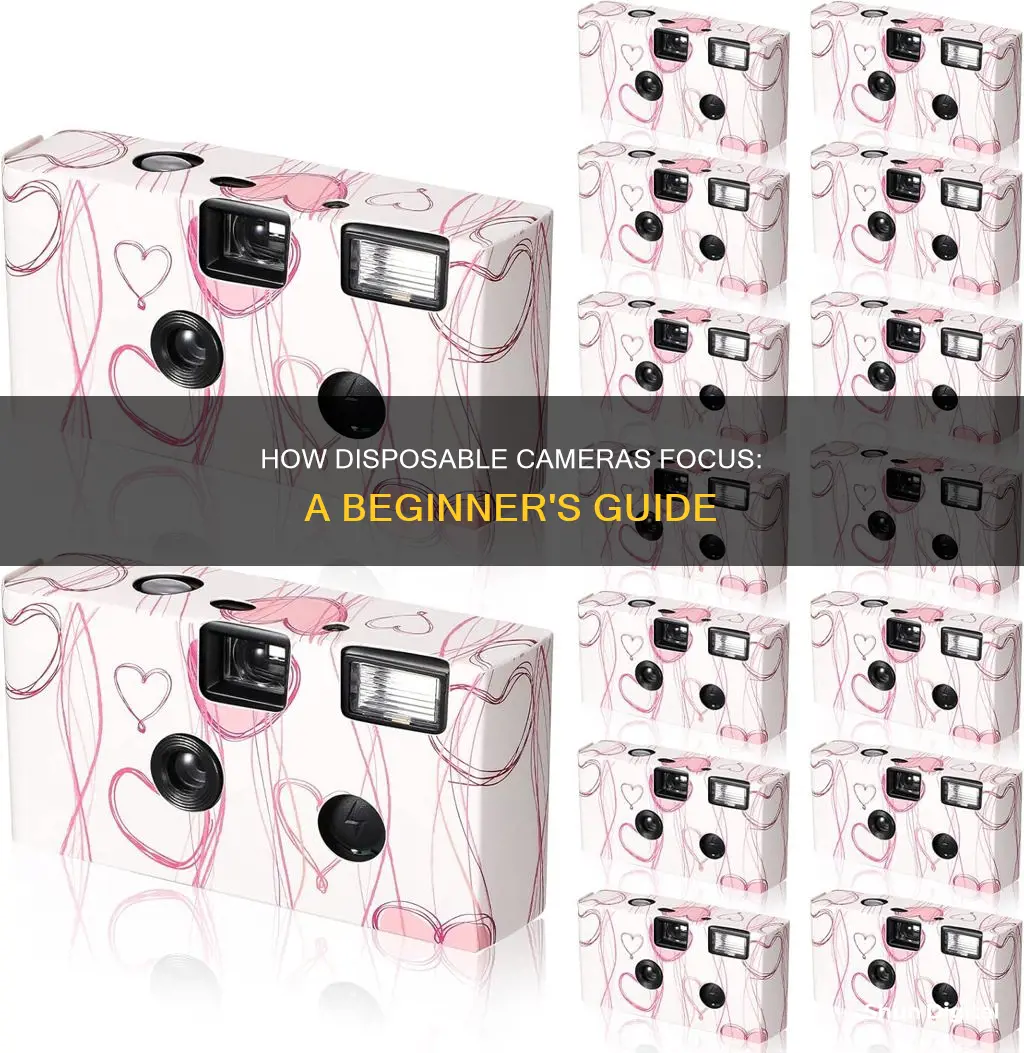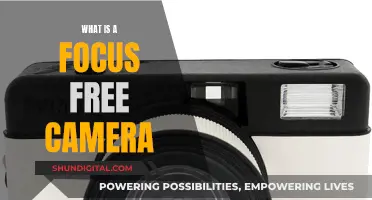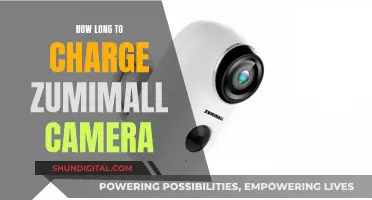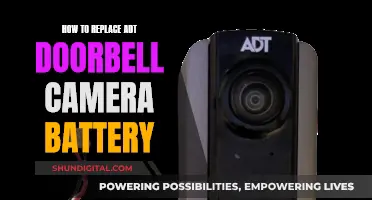
Disposable cameras are small, simple cameras that come preloaded with either colour or black-and-white film. They have no focus or exposure controls other than a built-in flash and are meant to be used once by the photographer. The focus on disposable cameras is fixed, with a small, fixed aperture, and it is the photographer's job to position themselves at the required distance to capture the intended subject in focus. The focus cannot be expected to be of impressive sharpness, but most things at most distances will be acceptably sharp. This is due to the small apertures, which expand the depth of field.
| Characteristics | Values |
|---|---|
| Shutter Speed | Around 1/100s |
| Aperture | f/10 |
| Focal Length | 30mm |
| Optimal Focal Plane | 1-2m from the camera |
| Focusing Range | Fixed |
| Focus Quality | Acceptable sharpness |
| Flash Range | 5-10 feet |
What You'll Learn
- Disposable cameras have a fixed focus lens, with a set range of distances that will be in focus
- The photographer must position themselves at the required distance to capture the intended subject in focus
- Disposable cameras have a small, fixed aperture, which allows for a lot of depth of field
- The lens on disposable cameras is typically made of plastic, which limits the sharpness of photos
- Disposable cameras have a slow shutter speed, which can cause motion blur if the subject or the photographer moves

Disposable cameras have a fixed focus lens, with a set range of distances that will be in focus
Disposable cameras are simple to use and are designed for both amateur and professional photographers. They have a fixed focus lens, with a set range of distances that will be in focus. This means that the camera will only focus on objects within a certain distance, typically around 4 to 10 feet from the camera. Anything closer or farther away may appear blurry. The fixed focus lens allows the camera to capture a wide depth of field, keeping most objects in the scene in focus.
To get the sharpest results from a disposable camera, it is important to position your subject within the focus range of the lens. This is usually between 5 to 10 feet away from the camera, in the center of the frame. Keeping your subject within this "sweet spot" will help ensure they are in focus and the image is clear.
Disposable cameras also have a simplified interface and fewer features compared to reusable cameras. They typically lack auto-focus, zoom, and other advanced settings found on modern digital cameras. The flash on a disposable camera also needs to be turned on manually, and it will always flash when turned on, regardless of the available light.
Despite their limitations, disposable cameras can still produce good results, especially in bright lighting conditions. They are a fun and affordable option for photography, offering a nostalgic feel and the element of surprise as you won't see the photos until they are developed.
Exiting Camera Mode: Quick and Easy Steps
You may want to see also

The photographer must position themselves at the required distance to capture the intended subject in focus
Disposable cameras have a fixed focus lens, which means there is a set range at which they can take clear pictures. The photographer must be aware of this range and position themselves within it to get the best results. For most disposable cameras, this range is between 4 and 10 feet. This is known as the hyperfocal distance and it ensures that everything within this range appears in acceptable focus.
The photographer can also use the flash to guarantee that the film is well exposed and the developed image is of high quality. However, the flash will only work effectively for objects within the hyperfocal distance. It is also important to avoid using the flash when shooting reflective surfaces, as this will cause overexposure.
The disposable camera's focusing system is similar to zone focusing, where the camera settings are optimised to enable everything within a certain range of distances to be reasonably in focus. While the focus may not be of impressive sharpness, most things at most distances will be acceptably sharp due to the small apertures used.
To summarise, the photographer must be mindful of the fixed focusing range of a disposable camera and position themselves at the correct distance from the subject to capture sharp images. The use of flash can also improve image quality, but it is important to stay within the effective range of the flash and avoid reflective surfaces.
HDR Mode: Enhancing Your Mi Camera Experience
You may want to see also

Disposable cameras have a small, fixed aperture, which allows for a lot of depth of field
Disposable cameras are simple, lightweight, and cheap cameras with a pre-loaded roll of 35mm film. They are designed to be used once and then sent for processing. They have a fixed lens, a fixed aperture, and a fixed shutter speed, and the only variable is the film speed. The aperture is usually set between f/8 and f/11, which is considered a small aperture. This allows for a lot of depth of field, meaning that most things within a certain range of distances will be in focus. The photographer then just has to position themselves at the correct distance to capture the desired subject.
The small aperture on a disposable camera greatly expands the depth of field, allowing for many everyday scenarios to be captured. The focusing is done by the photographer, who must position themselves within the optimal range, usually around 1-2 metres from the subject. This is known as zone focusing, where the camera settings are optimised to enable everything within a certain range to be reasonably sharp. While the focus may not be of impressive sharpness, most things will be acceptably sharp at most distances.
The small, fixed aperture on disposable cameras is just one of several fixed settings, including the lens and shutter speed. The only variable is the film speed, which can usually be purchased in ISO 200, 400, or 800. The fixed settings and simple mechanics of disposable cameras mean that they are easy to use and perfect for capturing spontaneous moments.
Understanding Florida Camera Tickets: What You Need to Know
You may want to see also

The lens on disposable cameras is typically made of plastic, which limits the sharpness of photos
Disposable cameras are small, simple cameras that come pre-loaded with either colour or black-and-white film. They are designed to be accessible to both amateur and professional photographers. The lens on disposable cameras is typically made of plastic, which limits the sharpness of photos.
The plastic lens on a disposable camera is usually fixed-focus, meaning it has a set range at which it can capture clear pictures. This range is typically between 4 and 10 feet, or around 1.5 meters to infinity. The lens also has a small, fixed aperture, which affects the depth of field and the amount of light that enters the camera. The aperture on disposable cameras is usually set to a deep depth of field, allowing most objects in the scene to be in focus.
The quality of pictures taken with a disposable camera can vary depending on lighting conditions and the distance from the subject. Disposable cameras work best in bright, outdoor settings and struggle in low-light situations. The flash on a disposable camera can improve lighting, but it has a limited range and can be too strong for close-up shots.
Overall, while the plastic lens on disposable cameras may limit the sharpness of photos, they can still produce bright, high-contrast, and interesting images. The key to getting good results is understanding the camera's limitations and working within them.
Understanding Adobe Camera Raw: A Plugin Essential
You may want to see also

Disposable cameras have a slow shutter speed, which can cause motion blur if the subject or the photographer moves
Disposable cameras are a great, simple and cheap way to get into film photography. They are usually pre-loaded with a roll of 35mm film, a simple mechanical shutter, and some basic electronics. However, one of their limitations is their slow shutter speed, which can cause motion blur if the subject or the photographer moves.
Shutter speed refers to the length of time the camera shutter is open, exposing the image onto the camera sensor and film. A slow shutter speed means that the shutter is open for a relatively long time, which can lead to motion blur if there is movement during this time. This can happen if the subject of the photo is moving or if the photographer moves the camera slightly before clicking the shutter button.
To avoid motion blur, it is important to keep the camera still while shooting and to try to capture subjects that are not in motion. Additionally, disposable cameras perform better in bright, well-lit environments, so it is recommended to use the flash when taking photos, especially in low-light settings.
The shutter speed of disposable cameras is typically fixed at around 1/100th of a second. This is significantly slower than the shutter speeds used in sports photography or to capture fast-moving objects, which may require speeds of 1/1000th of a second or faster. While a slower shutter speed can cause motion blur, it can also be used creatively to convey a sense of movement and speed, such as in photos of cars or other vehicles in motion.
In conclusion, while disposable cameras have a slow shutter speed that can cause motion blur, this limitation can be mitigated by being mindful of the subject and photographer's movement and taking advantage of the flash to ensure well-lit photos.
How Long to Charge Mobius Cameras Fully?
You may want to see also
Frequently asked questions
Disposable cameras have a fixed focus lens, meaning there is a set range at which they take the most in-focus, clear pictures. The photographer must position themselves at the required distance to capture the intended subject in focus. The focus on disposable cameras cannot be expected to be of impressive sharpness, but most things, at most distances, will be acceptably sharp.
The optimal focal plane for a disposable camera is around 1-2m from the camera. This means that the camera will provide optimal sharpness for subjects shot within that range of distances.
This is achieved through a combination of a wide-angle lens and a small, dark aperture. The wider the angle, the deeper the field. A small, fixed aperture and focus on a reasonable distance will give a lot of depth of field.







